

|
Soundclip:
|
| See Steve's Hand-Written Solo transcription |
|
Steve Khan's
solo on: 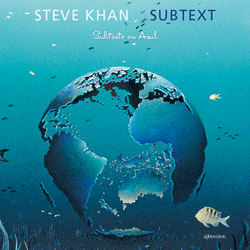 As this tune, played over a Cha-cha-cha groove, is at its core a C7 blues with a twist here and there, I wanted to come-up with not only a solo form that was related to the tune, but also, to have a section that would serve as an actual Prelude to the solo form. As this tune, played over a Cha-cha-cha groove, is at its core a C7 blues with a twist here and there, I wanted to come-up with not only a solo form that was related to the tune, but also, to have a section that would serve as an actual Prelude to the solo form.If you care to visit Pg. 3 of the Lead Sheet, you can see that there's even a little section, Letter [B], which is filled with chordal punctuations that takes us on a circuitous route to the IV7 chord, F7, and, after arriving there, we are transported to our Prelude to the solo, which had been labeled as [B2]. Harmonically speaking, there's really nothing to it. I am just playing over a sustained C7 chord, and initially the orchestration is only playing two notes, C-Bb, at middle 'C.' I have always liked this device, because it somehow sounds like more is going on, when actually it is only allowing you to hear all the harmonic extensions in your imagination. As long as you have an active imagination, there is virtually no place that you could not explore. As the section unfolds, various altered tones are added to those two notes, and the improvisation is loosely affected. Still, the order of the day is to always stick closely to blues-related material, even if some of it sounds a bit sideways. All the while, Dennis Chambers is layin' down some serious fatback that just makes you wanna get up and shout, "Good God!!!" And, when Dennis was listening to a playback, that's exactly what he said. It was great, and so very funny!!! If you have already listened to, and taken a look at the Zawinul-esque melodic material in the [A] section, you would have seen the references to C°7 ideas, which might have touched upon any of the important triad material contained within that structure. Those triads being: C, Eb, Gb, and A. So, at varying times, you might see portions of these triads used to bring us to notes that are more familiar sounding, and closer to the C7 blues language. That blues scale being: C, Eb, (E), F, Gb, G, Bb. As Dennis' wicked groove in [B2] is unfolding, I just chose to use the space with simplicity, and played something that always makes me think affectionately of guitarist, Hugh McCracken, whom I adored both personally and musically. This little motif becomes a bit of a theme throughout the 32-bar section. It appears in bars: 1-3, 7-8, and 32. 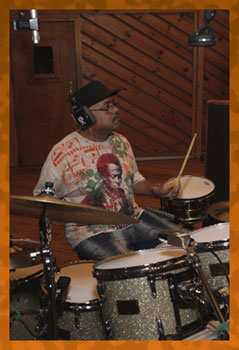 As I always seem to say, it's important to keep an improvisation loosely connected to melodic materials that have appeared before. So, certain linear configurations from the [A] melody section appear here as well. For example, take a look at the lines in bars: 9-12, 15-16, 25, and 30-31. I also spoke of the usage of various triads, though they might have been spelled enharmonically, they allude to the diminished cycle, and those appear in bars: 5(F#/Gb), 16(A), and 18(Gb). In the end, what becomes most important is the final note that your ear targets, and where you land. Another element that also came to me was to use actual triads, but played against an open string to create a kind of dissonance that is really very characteristic to the guitar. Though he really did not play things exactly like this, the technique makes me immediately think of the great Hungarian guitarist, Gabor Szabo, a favorite of mine. Playing over a static C7(with some alterations), your best option is to use the open E-string. So in bar 13, you will find a Gb triad, 2nd inversion with the note Gb played on your B-string. In bar 14, that voicing is answered by a 3rd inversion Eb triad with the note G-natural played on your B-string. In bar 20, you have two little punctuations played as a 3rd inversion Ab triad with the note 'C' played on your B-string at the 13th fret. This one chord color foreshadows what is to come later. In bar 26, you have a 3rd inversion Gb triad with the note Bb played on your B-string at the 11th fret. Finally, you have the nice motion back-and-forth between an Ab and Gb triad, both 3rd inversions, and played between the 13th and 11th frets. The ultimate resolution of these ideas falls on an Eb triad, also in the 3rd inversion, with the note 'G' played on your B-string. After this Prelude, we hit the true solo form for 4 choruses of a 16-bar blues form between [B3]-[B6]. Again, the groove changes as Marc Quiñones moves from his cha-cha bell to the mambo or salsa bell, and that is joined by the campana on the other side of the mix. All the while, as he played at the top of the tune and through the [A] section, Dennis is playing a cymbal pattern that I have loved since I was a teenager. It comes from an old Cal Tjader tune titled "Soul Motion." Thank goodness Dennis likes this groove, and as he played on "Change Agent," he does it here too, and with a big smile. You can't have a better person/drummer to work with than Dennis Chambers!!! Again, fundamentally we have a 16-bar blues form, but bars 9-12 are a little different, featuring 2 bars of Abm7-Db7 and 2 bars of Gbm7-B7. If one had been expecting to hear G7(V7) to F7(IV7), you could choose to view these new changes in a particular way, that Db7 is the b5 substitute for G7, and likewise B7 is the b5 substitute for F7. And, in the end, both chords surround our real center of C7 by a 1/2-step above and a 1/2-step below. It works out nicely to play over. Even though I really see the solo as one thought over the 4 choruses, let's break things down, and take a look at each one individually. As you might imagine, you will continue to see melodic threads from the [A] melody section as well as ideas that were introduced during the Prelude, [B2]. In the first bar of [B3] emphasis on simple triads continues as the first phrase puts to use an A major triad with C# on top to serve as an upper neighbor to the point of resolution, the root, C-natural. In bar 3, this thematic device continues as an F#/Gb triad is used to approach C-natural again, but this time from below, from Bb/A#. In bar 4, as the chord changes, the guts of Dbm7, an Fb triad, appears. Throughout the first 8-bars of the form there are linear references to parts of the [A] melody, but more than this, you hear the C blues scale [C, Eb, (E), F, F#, G, Bb]. 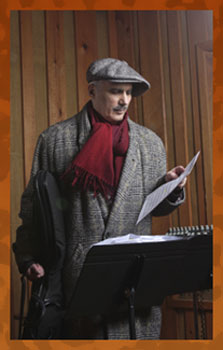 For bars 9-11, the elements of Jazz and its particular chromaticism begin to appear, though over the Abm7-Db7 bars, there is a chromatic reference to the Db7 dominant 7th pentatonic[Db, Eb, F, Ab, Cb]. Bar 11 is a mixture of linear influences, but it is probably most connected to B dominant 7th pentatonic[B, C#, D#, F#, A] with chromaticism. Over bar 12, I put to use triads, but this time as full chords, using a B triad to a C# triad. And, depending upon how one chooses to analyze this sound, the E#/F-natural within that C# triad, supplies us with the b5 relative to B7, or the maj7 relative to F#m9. Of course, no one "thinks" about this nonsense when one is playing! These are either sounds which you have become accustomed to, and they don't sound odd or forced when used - or, you aren't comfortable with them, and you are forcing them into the music. The latter usually does not produce the best, the most self-confident results. Bar 12 finishes up with chord voicings that I associate with McCoy Tyner and any of the great pianists that he served to influence in some way: Herbie Hancock, Chick Corea, Keith Jarrett, and countless others. This first chorus concludes with 4 bars of more blues-based material, but take a closer look at bar 15, as the 'A' triad reappears with a slightly different configuration, but the target note of C-natural, the root, the harmonic center of the solo section is still there! The chorus closes out with a little line configuration that is a tribute to how Joe Zawinul always seemed to find a way of putting to use the major 3rd, the most vanilla note in any blues, and somehow tucking it in, and making it work. For bars 9-11, the elements of Jazz and its particular chromaticism begin to appear, though over the Abm7-Db7 bars, there is a chromatic reference to the Db7 dominant 7th pentatonic[Db, Eb, F, Ab, Cb]. Bar 11 is a mixture of linear influences, but it is probably most connected to B dominant 7th pentatonic[B, C#, D#, F#, A] with chromaticism. Over bar 12, I put to use triads, but this time as full chords, using a B triad to a C# triad. And, depending upon how one chooses to analyze this sound, the E#/F-natural within that C# triad, supplies us with the b5 relative to B7, or the maj7 relative to F#m9. Of course, no one "thinks" about this nonsense when one is playing! These are either sounds which you have become accustomed to, and they don't sound odd or forced when used - or, you aren't comfortable with them, and you are forcing them into the music. The latter usually does not produce the best, the most self-confident results. Bar 12 finishes up with chord voicings that I associate with McCoy Tyner and any of the great pianists that he served to influence in some way: Herbie Hancock, Chick Corea, Keith Jarrett, and countless others. This first chorus concludes with 4 bars of more blues-based material, but take a closer look at bar 15, as the 'A' triad reappears with a slightly different configuration, but the target note of C-natural, the root, the harmonic center of the solo section is still there! The chorus closes out with a little line configuration that is a tribute to how Joe Zawinul always seemed to find a way of putting to use the major 3rd, the most vanilla note in any blues, and somehow tucking it in, and making it work.As Chorus 2, [B4] begins, another brief chordal passage appears, and where Latin music is concerned, I associate these colors and movements with Chick Corea and how he was playing on Cal Tjader's classic "SOUL BURST" album. In bar 3, instead using the expected modal notes over a C7 chord, C Mixolydian [C, D, E, F, G, A, Bb], I like to employ Db(b2 or b9), which is really just a chromatic upper neighbor to our root, but it gets us away from certain traditional linear sounds. In bar 4, I simply observed the Coltrane b7 (ii-V) sub, in this case, Dbm7-Gb7, with a descending line that lands right on a most consonant note on the downbeat of bar 5 as the IV chord, F7, hits. Notice the little ornament on beat 2 of bar 4. These are the kinds phrasing techniques that often make the difference between sounding stylistically consistent with the genre, or just blowing through the changes. If you don't employ these little touches, something will always be missing from your playing. In bar 6, even though the common chordal device of inserting an F#°7 chord does not appear, I alluded to it with my line in the 2nd half of that bar. In bar 8, with the Abm7-Db7 chord change coming in bar 9, I chromatically approached it from below by playing B7(13)-C7(13)-Db7(13). In bar 9, I flirted briefly with a little montuno device that I owe to the great pianist/arranger Oscar Hernández, who has shared so many things with me about this glorious genre. Bobby Allende must have heard something familiar, because he really gave his conga a loud slap! I love how the inner voice moves up from the F-natural. Many players would have simply descended from Ab. I love doing this Oscar's way. Again, over these chords, just like I did in bar 12 of Chorus 1, I employ a series of major triads, brushing by an Eb major triad which, just as before, gives me the b5(G) against Db7, or the #7(G) against Abm9. I love these colors when they appear in this way, quickly dancing by, and really hardly noticed, but felt! As Chorus 2 comes to a close, some R&B and Gospel elements filter in. The little idea that I play in bar 13, I always associate with Herbie Hancock's playing. He never seems to lose touch with his roots, even if the actual music of the moment is way farther out there than that. Bar 14 contains the Gospel element where you hear simple triads: D minor and C major over a bass note of C. In bars 15-16, I have no idea how these country music elements filtered into this solo, because I can only admire the great players in that genre, but I guess I must have channeled my best Jerry Reed or Brent Mason impression with my pick & claw for these two bars? The sustain of the 4th, G-C, carries us over into the first 2 bars of Chorus 3, [B5], and that is punctuated with a C7(#9) voicing that I probably first heard on Kenny Burrell's great tune, "Chitlins Con Carne" back in the mid-'60s. It's most effective here because it is sustained, and it's the first time that this sonority has appeared during the solo. Bar 4, over the Dbm7-Gb7, sees yet another chromatic Be-bop oriented line that cadences in Bar 5 to the IV7(F7) chord by resolving to the 3rd, A-natural. This phrase is then answered with a kind of double-stop technique that I have always associated with the piano, and in this case it involves keeping the root(C-natural) on top of the moving line that is really using the blues language. In bars 7-8, the variations continue on putting to use the major 3rd and the blue note of the minor 3rd. Again, these ideas were all revealed in the original [A] melody. 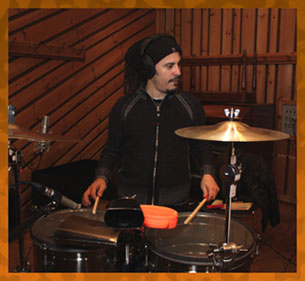 In bar 9, as the Abm7-Db7 chords arrive, the line is probably most associated with chromatic modal Jazz phrasing in and around the Db dominant 7th pentatonic[Db, Eb, F, Ab, Cb]. Bars 10-12 feature a completely different usage of 3-note chords played against an open string. But this time, that open string is our B-string. Against Abm7 and Db7, that note, B-natural, should also be viewed as Cb, a part of each of those chords. Against the sustain of that Cb, I am playing F-Bb-Eb (spelling up) by flattening my 3rd finger over all those notes, but the rhythm that I used briefly alludes to a montuno. The motif carries over into bars 11-12 and the F#m7-B7 changes, but here I change to use parallel major triads (C#-B-A) against that open B-string pedal. The C# major triad, once again, brushes by an E#(F), which is the b5 of B7, and the #7 of F#m9. For me, the nice touch when doing this is play everything purposely behind the beat, really laid back. When we arrive at bar 13, and we are back to the C7 sound, the Gospel sounds of simple triads appear with D minor and C major both over the root of C-natural. In bar 14, the parallel voicings of Ebm7(sus)-Fm7(sus)-Gbm7(sus)-Abm7(sus) serve to expand the harmony from the prior moments of simplicity. If one learns to hear things this way, it can make perfect musical sense. Not to be repetitive, but this all harkens back for me to the way Chick Corea was playing Latin music on "SOUL BURST." Bar 15 offers a brief touch of blues or R&B oriented double-stops before a breath is taken in the first half of bar 16. To shoot us into the next chorus, even though the bass never plays a G7 chord there, your line can always imply the altered V7 chord, and that's what happens here. One of the most traditional cadences in Jazz is to use a simple augmented triad, and on beat 4, I just spell out G-D#-B-G to resolve to C-natural on the first beat of Chorus 4. It's so elementary, but very effective. You see this linear configuration all the time during so many of the great Charlie Parker solos. In bar 9, as the Abm7-Db7 chords arrive, the line is probably most associated with chromatic modal Jazz phrasing in and around the Db dominant 7th pentatonic[Db, Eb, F, Ab, Cb]. Bars 10-12 feature a completely different usage of 3-note chords played against an open string. But this time, that open string is our B-string. Against Abm7 and Db7, that note, B-natural, should also be viewed as Cb, a part of each of those chords. Against the sustain of that Cb, I am playing F-Bb-Eb (spelling up) by flattening my 3rd finger over all those notes, but the rhythm that I used briefly alludes to a montuno. The motif carries over into bars 11-12 and the F#m7-B7 changes, but here I change to use parallel major triads (C#-B-A) against that open B-string pedal. The C# major triad, once again, brushes by an E#(F), which is the b5 of B7, and the #7 of F#m9. For me, the nice touch when doing this is play everything purposely behind the beat, really laid back. When we arrive at bar 13, and we are back to the C7 sound, the Gospel sounds of simple triads appear with D minor and C major both over the root of C-natural. In bar 14, the parallel voicings of Ebm7(sus)-Fm7(sus)-Gbm7(sus)-Abm7(sus) serve to expand the harmony from the prior moments of simplicity. If one learns to hear things this way, it can make perfect musical sense. Not to be repetitive, but this all harkens back for me to the way Chick Corea was playing Latin music on "SOUL BURST." Bar 15 offers a brief touch of blues or R&B oriented double-stops before a breath is taken in the first half of bar 16. To shoot us into the next chorus, even though the bass never plays a G7 chord there, your line can always imply the altered V7 chord, and that's what happens here. One of the most traditional cadences in Jazz is to use a simple augmented triad, and on beat 4, I just spell out G-D#-B-G to resolve to C-natural on the first beat of Chorus 4. It's so elementary, but very effective. You see this linear configuration all the time during so many of the great Charlie Parker solos.Chorus 4, [B6], of the solo offers an interesting structural oddity in that, if you view the page, it still appears to be 16 bars in length, but the actual soloing ends on beat 1 of the 14th bar!!! When I was composing the structure of the solo, or arranging it, for some reason, this just felt right to me. And I believe that when you hear it, as a listener, it's going to sound musical to you as well. But, I can say that when we were rehearsing this point in the chart, it was really confusing for all the players. I guess that it eventually made enough musical sense that we got through it, and had a performance. As I stated when looking at the conclusion of Chorus 3, the last phrase cadences to a short quarter-note C-natural on the downbeat of bar 1. I left the rest of that bar empty, again another breath, and one of my favorite things about the performance happened when Marc Quiñones overdubbed the campana [which is the hand-held bongo bell that you hear on the right side of your stereo], he beautifully filled that empty space by reacting to what had just been played. Where Latin music is concerned, for me, that's just a perfect moment! The phrase in bar 2 begins with a linear device that I often like to employ, and that is that you begin a line with major triad that can either be 1/2-step above or below the tonal center. So here, I'm playing a B major triad, which is a 1/2-step below our C7 chord, but notice how the line works its way back into the C-blues language. Then, in bar 3, a similar device is used as, once again, an A major triad is played to emphasize the downward movement from C#(Db) to C-natural, the root of C7. In bars 4 and 5, I returned to the country-esque pick & claw technique. 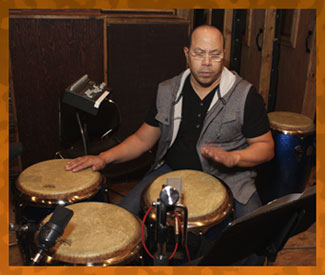 If you think of the chords as moving from Gb7 to F7, what I'm doing is superimposing this musical idea by playing fragments that lay well on the guitar, and could be seen as playing Db minor pentatonic[Db, Fb, Gb, Ab, Cb] over the Gb7, and then C minor pentatonic[C, Eb, F, G, Bb] over the F7 chord. If you look at all the notes, played in 3rds and 4ths, they should stick pretty close to those suggested notes. In bar 6, the line is a reflection of earlier material that references C°7 and, used skillfully, resolves itself to C7. And this is exactly what you see and hear. After a breath, in bars 7-8, once again you see the playing of both E-natural and Eb, but in reverse order, meaning that the usual way, the Eb would normally be bent-up and barely touch upon E-natural. But here, the E-natural comes first, and goes down to Eb, which serves to accentuate the blue note aspect more. The cadence to our root is also done from its chromatic upper neighbor Db. The final flurry within bars 9 through 12 is made-up of 2 phrases. Over the Abm7-Db7 bars, with some chromaticism included, the shape of the line is really a product of Db dominant 7th pentatonic[Db, Eb, F, Ab, Cb]. If you look closely, you would see a lot of those notes. In bars 11-12, where the chords go down a whole-step to Gbm7(F#m7)-B7, the line begins with some chromaticism, but this time, this line is really born of putting to use the F# Dorian mode (as it was spelled on the transcription) [F#, G#, A, B, C#, D#, E]. However, on beat 2 of bar 12, there is another nice little twist using a major triad again. Here I played a C# major triad, and again, the color it supplies, but ever so quickly, is to introduce the tone of E#(F) which is the #7 of F#m9, or the b5 of B7. That E#(F) leads me nicely into the note, F#, which is of course, the 5th of B7, and the phrase concludes with a very common blues-based idea. As the band breaks on beat 1 of bar 13, the solo concludes with a phrase that, from a purely guitar perspective, involves a string-skipping device, and again the line highlights the contrast between Eb and E-natural. And, of course, this is very much related to melodic material that appeared in the [A] melody section. If you think of the chords as moving from Gb7 to F7, what I'm doing is superimposing this musical idea by playing fragments that lay well on the guitar, and could be seen as playing Db minor pentatonic[Db, Fb, Gb, Ab, Cb] over the Gb7, and then C minor pentatonic[C, Eb, F, G, Bb] over the F7 chord. If you look at all the notes, played in 3rds and 4ths, they should stick pretty close to those suggested notes. In bar 6, the line is a reflection of earlier material that references C°7 and, used skillfully, resolves itself to C7. And this is exactly what you see and hear. After a breath, in bars 7-8, once again you see the playing of both E-natural and Eb, but in reverse order, meaning that the usual way, the Eb would normally be bent-up and barely touch upon E-natural. But here, the E-natural comes first, and goes down to Eb, which serves to accentuate the blue note aspect more. The cadence to our root is also done from its chromatic upper neighbor Db. The final flurry within bars 9 through 12 is made-up of 2 phrases. Over the Abm7-Db7 bars, with some chromaticism included, the shape of the line is really a product of Db dominant 7th pentatonic[Db, Eb, F, Ab, Cb]. If you look closely, you would see a lot of those notes. In bars 11-12, where the chords go down a whole-step to Gbm7(F#m7)-B7, the line begins with some chromaticism, but this time, this line is really born of putting to use the F# Dorian mode (as it was spelled on the transcription) [F#, G#, A, B, C#, D#, E]. However, on beat 2 of bar 12, there is another nice little twist using a major triad again. Here I played a C# major triad, and again, the color it supplies, but ever so quickly, is to introduce the tone of E#(F) which is the #7 of F#m9, or the b5 of B7. That E#(F) leads me nicely into the note, F#, which is of course, the 5th of B7, and the phrase concludes with a very common blues-based idea. As the band breaks on beat 1 of bar 13, the solo concludes with a phrase that, from a purely guitar perspective, involves a string-skipping device, and again the line highlights the contrast between Eb and E-natural. And, of course, this is very much related to melodic material that appeared in the [A] melody section.As a young kid growing-up in Los Angeles, California, when I started buying all the classic LPs from the '60s and before, all these great albums often featured photos of the East Coast musicians dressed in winter coats and hats. I had never seen such clothing, and it just looked so hip to me, so jazzy! Of course, in Los Angeles, it never seemed, back then, that the weather ever went below 60°, so who would ever need such coats and hats? As we, here in New York, and the entire northeast, during 2013-14 were mired in one of the worst winters ever for both temperature and snowfall amounts, I wore my old Williwear overcoat, over layers of warm clothes, and my Big Apple Newsboy cap almost every day. So, when I arrived at the studio, and Rick Laird was there to take photos that day, I wanted to recall the glorious past of this music, and get a couple of shots with me in my winter garb, and my guitar still in its gig bag. So, that's why I'm sharing one of those photos today.
[Photos: Dennis Chambers; Steve; Marc Quiñones and Bobby Allende
by: Richard Laird] |